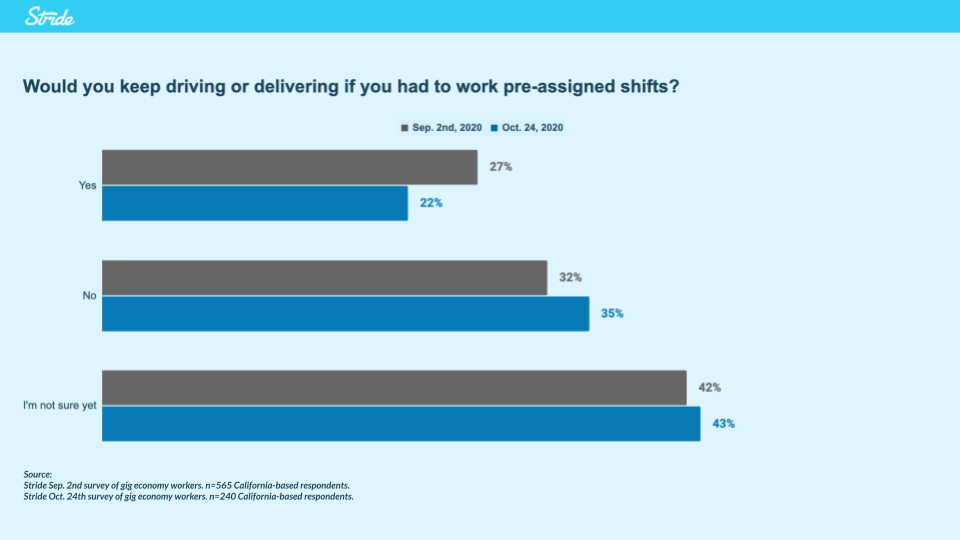How Gig Economy Workers Plan To Vote on Prop 22
In less than a week, voters in California will decide whether Proposition 22 will pass, which proposes an alternative approach to AB-5 for compensating and protecting delivery and rideshare gig economy workers.
Here at Stride we’re focused on helping independent contractors and part-time workers get affordable, portable benefits, and over the years have helped over 1.8 million independent workers find affordable health, dental, vision and life insurance, estimate and lower their taxes, and save money on everything from prescriptions to car repairs. So we were interested to see how rideshare and delivery drivers felt about employment classification and how they plan to vote so we can deliver the next set of benefits to solve their biggest challenges, and help them achieve the financial security they deserve.
We conducted two surveys approximately 7 weeks apart to measure attitudinal trends among gig workers: the first in early September and the second in late October.
Here’s what we found.
Rideshare drivers overwhelmingly (80%) would prefer to remain classified as independent contractors, slightly more so now than in September:
Delivery drivers felt even more strongly (84%) about this classification, both compared to rideshare drivers and to the September respondents:
Awareness of Prop 22 among California gig workers has risen over 50% in the past 7 weeks and now, and nearly 90% of gig workers are familiar with it:
Among those familiar with Prop 22, 30% more are now planning to vote “Yes” than in September:
When compared to the general voting population, California rideshare and delivery drivers are 35% more likely to vote Yes on Prop 22:
If forced to work pre-assigned shifts, just 22% plan to continue to drive or deliver, though 43% remain undecided:
And many are less likely to drive if their hours were capped at 30 hours per week, but 50% are undecided:
In this latest survey, we asked two additional questions: the first, was about voter registration, and it turns out that 82% of people are:
And of those who are...most are planning to vote:
This survey suggests rideshare and delivery drivers in California wish to remain classified as independent contractors and plan to support Proposition 22, which preserves their independent contractor status, but calls on the flexible work platforms to provide minimum wages, paid-time off and provide additional funds these workers can use to secure their own benefits.
It also reveals a growing awareness outside of California of classification legislation, and it’ll be interesting to see if other states push for similar measures.
Regardless of how that all shakes out, the team here at Stride will be ready to help all independent contractors across the United States save time and money on health, dental, vision, life insurance and more.
METHODOLOGY
We surveyed over 1,300 gig workers in late August through early September, and again in late October to get their perspectives on employment classification legislation. Both samples were drawn from Stride users who indicated they were rideshare and/or delivery drivers, and/or worked for one of the several gig economy platforms.
Respondents were contacted via email, and asked to take an online survey. Respondents who completed the survey were eligible to be entered into a drawing to win one of five Amazon $100 gift cards.
The first survey opened on August 28, and closed on September 2. 1,531 respondents took the survey.
The second survey opened on October 22, and closed on October 26. 1,350 respondents took the survey.
The questions were the same in both surveys, with the exception of two additional questions in the October survey “Are you registered to vote?” and “Are you planning to vote?”









